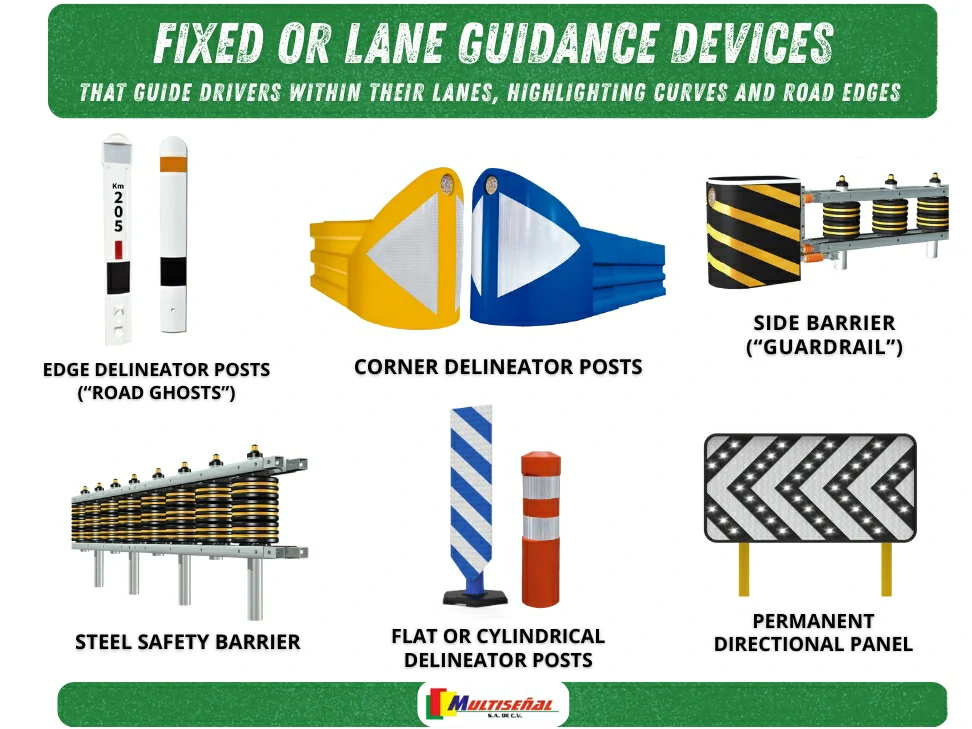Roadway delineation may not be a term you hear every day, yet it plays a vital role in every trip we take. It’s the system of signs and safety devices placed on roads to guide drivers, safeguard pedestrians, and protect workers. Without this essential system, traffic would be unpredictable—and far more dangerous.
In real-world driving, road delineation is essential. It keeps traffic moving smoothly, directs drivers through detours, highlights construction zones, and reinforces safety—whether the situation is temporary or permanent. These safety solutions fall into two key categories: temporary devices and fixed guidance systems.
Many of these elements come with technical names inspired by their design and purpose. Yet, traffic regulations and industry standards have defined more consistent terminology to ensure clarity for both drivers and authorities. For this reason, the infographics you’ll find in this blog feature the official terms, helping you recognize and understand each device in any road context.
Temporary Roadway Delineation Devices
Temporary roadway delineation devices are designed for short-term use on roads. They warn of immediate risks, outline work areas, and guide traffic safely around obstacles. These solutions stand out for their visibility, quick installation, and durability under demanding conditions.
- Type 2 Barricade: Designed for road closures, this barrier ensures a secure separation between traffic and pedestrians, keeping everyone safe.
- Traffic Barricade: Perfect for restricting or directing traffic in parking areas, controlled access points, or massive events.
- Arrow Board: A luminous panel that clearly indicates the direction to follow, even in nighttime conditions.
- Plastic Road Barriers: These barriers can be deployed in different scenarios, combining strength with effortless setup.
- Solar Traffic Cones: Combining classic design with modern innovation, these cones provide the convenience of a traditional cone plus the enhanced visibility of built-in solar lights.
- Lighted Delineator Post with Base: It guides vehicles safely during lane shifts or long detours.
- Traffic Drum With Light: A classic in roadwork sites, this barrier grabs attention with its bold presence and high-visibility reflective stripes.
- Solar Vertical Traffic Panel Barricade: Lightweight and easy to spot, this barrier is perfect for defining temporary entrances or crosswalks.

Roadway Delineation Solutions: Fixed and Directional Guidance Devices
Unlike temporary devices, these remain permanently installed within the road infrastructure. Their role is to guide traffic and enhance safety at critical points such as curves, entrances, bridges, and high-speed roads.
- Delineator Posts or Roadway Lighting Indicators: Compact in size, yet highly effective in guiding traffic and ensuring safer nighttime visibility.
- Delineator Posts: Built to be durable and reflective, they keep vehicles safely aligned on the road.
- Attenuator Highway: Designed with an impact-absorbing system to enhance safety and reduce collision risks.
- Highway Traffic Attenuator: Enhanced-capacity model, ideal for areas with intense vehicle flow.
- Smart Cushion Impact Attenuator: Integrates roller and shock-absorbing systems for maximum protection of roads, structures, and drivers.
- Traffic Barricades: Durable installation developed to increase protection on sharp or high-risk curves.
- Blue-and-white road delineator post: A vertical marker designed to channel traffic safely through intersections and entryways.
- Delineator Tube: Flexible and durable, it defines lanes without damaging vehicles.
- Signs of Solar Construction: Portable, self-powered, and highly visible, using solar energy, perfect for maintenance areas or traffic guidance.

Innovation in Road Signs
The world of road delineation is advancing alongside mobility needs. Today’s solutions feature ultra-bright LED lighting for superior visibility, incorporate recycled materials for sustainable durability, and increasingly integrate smart systems that respond dynamically to traffic conditions.
If you want to learn more about the regulations for these devices, consult the Mexican official standards, find out what they are about, to understand their focus on road infrastructure. Another key element of traffic signage is thermoplastic paint, which enhances safety, ensures long-lasting performance, and significantly improves visibility on city streets and highways.
With a better understanding of these roadway delineation devices, spotting them on streets and highways becomes simple. Knowing their purpose not only helps you grasp traffic signage more effectively but also reinforces why following them is essential for keeping everyone safe on the road.
